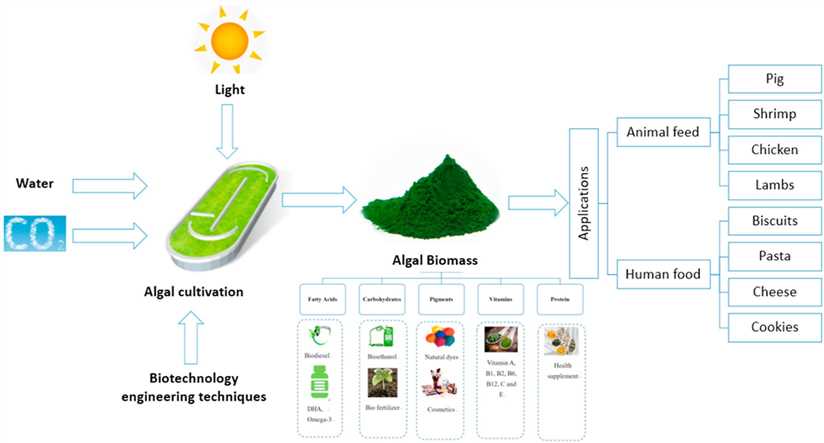The application of microalgae in aquaculture is mainly related to its nutritional composition, containing polyunsaturated fatty acids, proteins and vitamins. The current global market for microalgae-based food and feed supplements/nutraceuticals is well developed and has huge growth potential. Here, Lifeasible offers specialized solutions for the genetic engineering of microalgae for food and feed production.
With the growing global population, it is estimated that hunger affects one in nine people worldwide. We need to come up with a new and sustainable approach. Many species of algae are nutritionally complete foods, producing more than most plant crops. Because of their rich biochemical composition, microalgae are a promising solution as a sustainable food source with functional quality and nutritional value. Their long-chain polyunsaturated fatty acids, such as eicosapentaenoic and docosahexaenoic acids, are essential food supplements. At the same time, several other proteins and pigments have been associated with nutraceutical and pharmaceutical applications for treating a wide range of diseases. However, the research and value of microalgae as a natural source for a healthy diet remains low to date. Many improvements are still needed before microalgae can become a regular food source and mature crop.
 Fig 1. Microalgae as a sustainable food and feed source for animals and humans. (Kusmayadi A, et al., 2021)
Fig 1. Microalgae as a sustainable food and feed source for animals and humans. (Kusmayadi A, et al., 2021)
Since different microalgae strains provide a wide range of nutrients, it is important to study the application of these useful algae in human food and animal feed. Based on our cutting-edge genetic engineering tools and advanced strain selection techniques, Lifeasible establishes microalgae as a new platform for food and feed.
In producing microalgae as a food and feed source, we select suitable microalgae strains for genetic modification to improve the following traits or even add new ones. We aim to improve not only the productivity and nutritional content of the strain but also its organoleptic characteristics so they are attractive to the human or animal palate.
One of the most important nutritional characteristics of algae is the protein content and quality, which is determined by many genes. We offer mutagenesis methods to obtain and screen strains that accumulate high protein levels. In addition, we develop appropriate production processes that allow the expression of high-protein expression phenotypes.
Omega-3 and 6 fatty acids are essential long-chain polyunsaturated fatty acids (LC-PUFAs) that must be included in the daily diet. We achieved lipid accumulation to high levels in microalgae by genetic modification in suitable growth environments.
We genetically modify microalgae to express the desired genotypes to accumulate carotenoids, colostrum proteins, and vitamins to higher levels.
The organoleptic traits (taste, aroma, and texture) of microalgae will be key factors for human and even animal acceptance. We can engineer good tasting molecules into microalgae through DNA recombination technology, which directly changes their taste.
At Lifeasible, we can quickly help you engineer microalgal strains to obtain food and feed production traits. We are your trusted partner in all aspects of microalgae research. If you are interested in our solutions for the genetic engineering of microalgae for food and feed production, please do not hesitate to contact us.
Reference